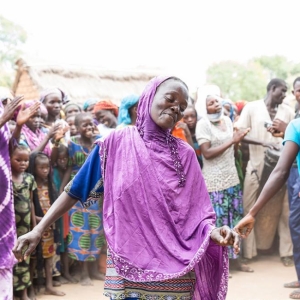En 2015, la Organización Internacional para las Migraciones (OIM) desarrolló un Marco de Gobernanza de la Migración (MiGOF) para ayudar a los Estados a definir los elementos esenciales que constituyen la base necesaria para una “política de migración bien gestionada” a nivel nacional. El MiGOF fue bien recibido por los Estados Miembros de la OIM el mismo año. Los Indicadores de Gobernanza de la Migración (IGM) han sido desarrollados para operacionalizar el MiGOF a través de cerca de noventa indicadores agrupados en seis dimensiones claves de políticas públicas.
Haga clic en la rueda para obtener más información sobre las seis dimensiones de la gobernanza de la migración incluidas en el MiGOF y los IGM.
Los IGM son una herramienta basada en el análisis de las estructuras de la gobernanza migratoria que presenta una serie de pautas sobre los instrumentos que el Estado podría usar para desarrollar su gobernanza. Los IGM evalúan únicamente el marco institucional, jurídico y de políticas públicas en materia de migración, sin entrar a evaluar su implementación en la práctica. Los IGM funcionan como un marco de referencia que permite identificar medidas que los países podrían adoptar para fortalecer sus estructuras de gobernanza de la migración. El objetivo de los IGM es contribuir a la conversación sobre la gobernanza migratoria definiendo lo que podría ser una “política migratoria bien gestionada” en el contexto de la meta 10.7 de los Objetivos de Desarrollo Sostenible (ODS).
Para obtener más información sobre el proceso de los IGM, haga clic aquí
Los indicadores de este dominio analizan los derechos de los migrantes a los servicios sociales básicos, como la salud, la educación y la seguridad social. Estos también presentan los derechos de los migrantes a la reunificación familiar, al trabajo, a la residencia y a la ciudadanía. La ratificación de las principales convenciones internacionales también se incluye dentro de este dominio.
Los indicadores de esta categoría se utilizan para definir la medida en que las personas migrantes tienen acceso a determinados servicios sociales, como la salud, la educación y la seguridad social. También remiten a las medidas adoptadas para garantizar la integración y el acceso al empleo.
Los indicadores en este dominio evalúan los marcos institucionales, legales y regulatorios de los países relacionados con las políticas migratorias. También revisan la existencia de estrategias nacionales de migración que están en línea con el desarrollo, así como la transparencia institucional y la coherencia en relación con la gestión de la migración. Este dominio investiga en qué medida los gobiernos recopilan y usan los datos de migración.
Los indicadores de esta categoría sirven para evaluar los marcos institucionales de autoridades locales o estados en lo referente a la migración. También permiten determinar la existencia de estrategias migratorias que sean acordes a los objetivos de desarrollo, así como la transparencia y coherencia institucional en relación con la gestión de la migración.
Este dominio se enfoca en los esfuerzos de los países para cooperar con otros Estados y con actores no gubernamentales (incluyendo organizaciones de la sociedad civil y el sector privado) en asuntos relacionados con la migración. La cooperación puede conducir a mejoras en la gobernanza al alinear y elevar los estándares, aumentar el diálogo y proporcionar estructuras para superar desafíos.
Los indicadores de esta categoría se centran en las medidas adoptadas por autoridades locales o estados para cooperar con los gobiernos nacionales en torno a cuestiones migratorias, así como con otros agentes no gubernamentales pertinentes, como las organizaciones de la sociedad civil y el sector privado.
Este dominio incluye indicadores sobre las políticas de los países para gestionar el bienestar socioeconómico de los migrantes, a través de aspectos como el reconocimiento de las calificaciones educativas y profesionales de los migrantes, las disposiciones que regulan la migración estudiantil y la existencia de acuerdos laborales bilaterales entre países. Los indicadores se centran igualmente en las políticas y estrategias relacionadas con el compromiso de la diáspora y las remesas de los migrantes.
Los indicadores de esta categoría permiten evaluar las iniciativas de autoridades locales o estados en lo relativo a la movilidad de estudiantes internacionales, el acceso al mercado laboral y las condiciones de trabajo decente para los trabajadores migrantes. Los aspectos relativos a la participación de las diásporas y las remesas de las personas migrantes también pertenecen a esta esfera.
Este dominio estudia el tipo y el nivel de preparación de los países cuando se enfrentan a crisis de dimensiones de movilidad, vinculadas a desastres, el medio ambiente y/o conflicto. Las preguntas se utilizan para identificar los procesos vigentes para nacionales y no nacionales durante y después de un desastre, incluso si la asistencia humanitaria está igualmente disponible para los migrantes que para los ciudadanos.
Los indicadores de esta categoría se refieren al tipo y nivel de preparación de autoridades locales o estados a la hora de encarar los aspectos relativos a la movilidad en situaciones de crisis. Permiten indagar acerca de los procesos establecidos para las personas nacionales y no nacionales tanto durante como después de desastres, incluso cuando la asistencia humanitaria está disponible en la misma medida tanto para las personas migrantes como para las nacionales del país concernido.
Este dominio analiza el enfoque de los países respecto a la gestión migratoria en términos de control fronterizo y políticas de aplicación, criterios de admisión para migrantes, preparación y resiliencia en caso de flujos migratorios significativos e inesperados, así como la lucha contra la trata de personas y el tráfico ilícito de migrantes. También evalúa los esfuerzos y los incentivos para ayudar a integrar a los ciudadanos que regresan.
Los indicadores de esta categoría sirven para evaluar el enfoque que aplican autoridades locales o estados respecto del acceso de las personas migrantes a políticas de seguridad, retorno y reintegración, así como en lo relativo a la lucha contra la trata de personas.
This local Profile describes examples of well-developed areas of State of Rio Grande do Norte (Brazil)’s governance structures and areas with potential for further development, as evaluated through the six domains of the Migration Governance Indicators (MGI). These address migrants’ rights, a “whole-of-government” approach, partnerships, socioeconomic well-being of migrants, the mobility dimensions of crises, and safe and orderly migration.
Click the icons on the wheel to explore the key findings.
The Migration Governance Indicators (MGI) initiative is a policy-benchmarking programme led by the International Organization for Migration (IOM) and implemented with research and analysis from the Economist Impact. Funding is provided by IOM Member States.
Migration Governance: examples of well-developed areas
- The State Plan for the Care of Refugees, Stateless Persons, and Migrants of Rio Grande do Norte 2021–2024 aims to streamline access to public health services and promote training and awareness on healthcare access for all migrants, regardless of their migration status.
- Migrants in Rio Grande do Norte can access social housing programmes, including the "My House, My Life" programme, if registered on the Unified Registry (Cadastro Único).
- Migrants and refugees can access support services at Brazil’s Social Assistance Reference Centres (Centros de Referência de Assistência Social, CRAS) and Specialized Social Assistance Reference Centres (Centro de Referência Especializado de Assistência Social, CREAS).
- Rio Grande do Norte offers free legal services to migrants through the State Policy for the Care of Refugees, Stateless Persons, and Migrants (PEARAM/RN) (2023) and the Public Defender’s Office (DPE/RN).
- The Department for the Protection of Vulnerable Groups in Rio Grande do Norte addresses xenophobia and racism. The State ran awareness campaigns in 2022 and 2023, and the PEARAM/RN outlines measures to combat hate crimes and discrimination.
Areas with potential for further development
- Establishing orientation programmes for newly arrived migrants is an area with potential for further development.
- The State Secretariat for Women, Youth, Racial Equality, and Human Rights has general child protection measures, but there are no specific state-level measures for unaccompanied or separated migrant children.
Migration Governance: examples of well-developed areas
- The Intersectoral State Committee for the Care of Refugees, Stateless Persons, and Migrants of Rio Grande do Norte (CERAM/RN) is responsible for designing and overseeing local migration policies and strategic plans.
- The State Secretariat of Labour, Housing, and Social Assistance (SETHAS), through the Coordinator of Migration Policy and the Rights of the Elderly (COMIPI), implements migration policies and strategic plans, providing support for CERAM/RN's operations and ensuring migrants' access to public services.
- CERAM/RN and SETHAS coordinate the implementation of migrant services, with CERAM/RN fostering local initiatives and SETHAS overseeing the State Plan for the Care of Refugees, Stateless Persons, and Migrants 2021–2024.
- The State Policy for the Care of Refugees, Stateless Persons, and Migrants (PEARAM/RN) (2023) is gender-responsive and aligns with the State’s development plan: the Multi-year Plan 2024–2027.
Areas with potential for further development
- Establishing an agency or department to coordinate efforts with diaspora groups is an area with potential for development.
- The regular collection and publication by the State of migration data, especially data disaggregated by country of origin, gender, age, and race/ethnicity, is an area with potential for further development.
Migration Governance: examples of well-developed areas
- The State Administration of Rio Grande do Norte engages civil society organizations (CSOs) in migration policy agenda-setting and implementation. The PEARAM/RN (2023) emphasizes collaboration with CSOs, higher education institutions, international organizations, and migrants.
- Migrants’ associations are actively involved in agenda-setting and policy implementation. CERAM/RN includes representatives from the Muslim Charitable Society of Rio Grande do Norte and the Association of Solidarity with Immigrants in Rio Grande do Norte.
- In March 2024, Rio Grande do Norte held its First State Conference on Migration, Refuge, and Statelessness (I COMIGRAR-RN), promoting the participation of migrants and refugees and electing delegates for the Second National Conference on Migration, Refuge, and Statelessness (II COMIGRAR).
- The State of Rio Grande do Norte engages with academia to inform migration policies. CERAM/RN includes a representative from the State University of Rio Grande do Norte and has agreements with the University of São Paulo and FAPERN for training and monitoring migration-related programs.
Areas with potential for further development
- Increasing engagement with the private sector in agenda-setting and implementing migration-related programs and policies is a key area with potential for further development.
- Rio Grande do Norte is not yet part of any international network for knowledge-sharing and best practice exchange on migration issues.
Migration Governance: examples of well-developed areas
- The State Plan for the Care of Refugees, Stateless Persons, and Migrants in Rio Grande do Norte 2021–2024 includes measures to promote gender equality in the labor force, with a focus on migrant women.
- The State Policy for the Care of Refugees, Stateless Persons and Migrants in Rio Grande do Norte (PEARAM/RN) (2023) and the State Plan 2021–2024 promote ethical recruitment of migrant workers.
- Measures are in place to attract international students, including partnerships with academic institutions. The State Plan for Education in Rio Grande do Norte 2015–2025 aims to increase postgraduate enrollments and promote scientific and technological exchange with international institutions.
- The State University of Rio Grande do Norte (UERN) and the Federal University of Rio Grande do Norte (UFRN) have agreements for tuition exemptions and promoting positions for international exchange students and professors.
Areas with potential for further development
- Rio Grande do Norte does not conduct assessments to monitor local labor market demand for immigrants or the effects of emigration on the local labor market.
Migration Governance: examples of well-developed areas
- The State Multirisk Health Plan for Disasters (PEMSD/RN) published in 2022 aims to reduce socioenvironmental vulnerabilities to disasters by establishing guidelines for health sector organization, planning, preparation, and response.
- In 2022, Rio Grande do Norte created a local communication system integrated with the National Secretariat of Protection and Civil Defence (SEDEC) to receive disaster alerts through WhatsApp. Users can send and receive messages and access automated information, hotlines, and other resources.
- Rio Grande do Norte’s Multi-year Plan 2024–2027 (2024) includes programs and objectives related to displaced migrants, such as establishing protection centres for human trafficking and forced labour cases, and developing mapping studies to identify vulnerable and at-risk areas for disasters and displacement.
Areas with potential for further development
- Establishing a disaster risk reduction management strategy with provisions for preventing and addressing the displacement impacts of disasters is an area with potential for further development.
- Rio Grande do Norte has yet to develop contingency plans for managing large-scale population movements during crises.
- Establishing formal coordination agreements and referral systems for assisting migrants during local emergencies is an area with potential for further development.
Migration Governance: examples of well-developed areas
- Rio Grande do Norte has specific mechanisms to foster migrants’ access to justice, including public safety. The Civil Police is responsible for crime prevention and investigation, offering legal advice in person at police stations and through the Virtual Police Station, which is available only in Portuguese.
- Public servants in Rio Grande do Norte are trained in migration rules and migrants’ rights, with a specific budget in the Multi-year Plan 2024–2027 (2024) for annual courses.
- The State Policy for the Care of Refugees, Stateless Persons and Migrants in Rio Grande do Norte (PEARAM/RN) (2023) incorporates the principle of preventing human trafficking of migrants and establishes the state government’s responsibility to actively prevent and report such crimes.
Areas with potential for further development
- Establishing a program focused on facilitating migrant reintegration at the local level is an area with potential for further development in Rio Grande do Norte.
- While local police officers in Rio Grande do Norte receive regular training in human rights, there is no evidence of specific and regular training on migration-related issues.
- Establishing a specific protocol or guidelines to respond to cases of disappearance or death occurring in the process of migration is another area with potential for development. Law No. 11.349 of 2023 introduced the State Educational Campaign on the Disappearance of Children and Adolescents, though it does not address migration-related disappearances or deaths.
2024 julio




